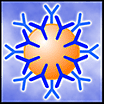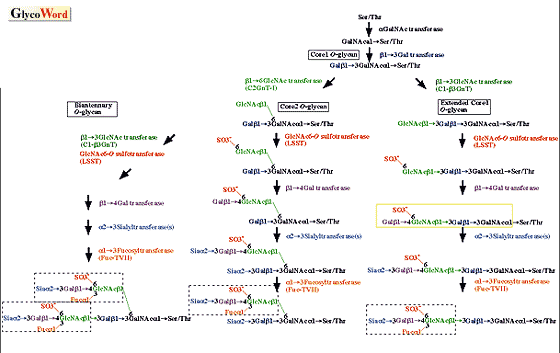 |
L-selectin is an adhesion molecule essential for lymphocyte homing. Lymphocytes circulate in the blood stream and move to secondary lymphoid organs, such as lymph nodes, to respond to foreign immunogenic antigens. L-selectin is expressed on lymphocytes and its counter-receptor is expressed on high endothelial venules, HEV, of lymph nodes, and lymphocytes extravasate through HEV in lymph nodes. L-selectin ligands on the HEV are thought to be sulfated sialyl Lewisx (sLex) expressed on mucin-type glycoproteins such as CD34 and GlyCAM-1. Recently, several glycosyltransferases and sulfotransferases that contribute to form L-selectin ligands were cloned and moverover, the mice with some disrupted genes were established. Recent progress in these areas is described below.
Decrement of L-selectin ligand activity was reported first in  1,3-fucosyltransferase VII (Fuc-TVII) knockout mice. However, neither CD34 nor GlyCAM-1 knockout mice showed diminished L-selectin ligand activity. The L-selectin ligand activity in the Fuc-TVII knockout mice is about 20% of that in wild type mice, indicating that fucosylation is necessary to make L-selectin ligands. Later Fuc-TIV and Fuc-TVII double knockout mice revealed almost no formation of L-selectin ligands, indicating that Fuc-TIV, an isozyme of Fuc-TVII, contributes to form the residual L-selectin ligands in the Fuc-TVII knockout mice. It has been shown that the isozyme having some different substrate specificity partially covers the reaction of the other isozyme. Generally, most glycosyltransferases and sulfotransferases have several isozymes, so that it is often difficult to analyze and interpret findings obtained from their gene knockout mice. 1,3-fucosyltransferase VII (Fuc-TVII) knockout mice. However, neither CD34 nor GlyCAM-1 knockout mice showed diminished L-selectin ligand activity. The L-selectin ligand activity in the Fuc-TVII knockout mice is about 20% of that in wild type mice, indicating that fucosylation is necessary to make L-selectin ligands. Later Fuc-TIV and Fuc-TVII double knockout mice revealed almost no formation of L-selectin ligands, indicating that Fuc-TIV, an isozyme of Fuc-TVII, contributes to form the residual L-selectin ligands in the Fuc-TVII knockout mice. It has been shown that the isozyme having some different substrate specificity partially covers the reaction of the other isozyme. Generally, most glycosyltransferases and sulfotransferases have several isozymes, so that it is often difficult to analyze and interpret findings obtained from their gene knockout mice.
An other group and we cloned L-selectin ligand sulfotransferase (LSST; alternatively cloned as HEC-GlcNAc6ST), which contributes to the synthesis of 6-sulfo sLex, and whose expression is localized in HEV of lymph nodes. 6-sulfo sLex on core2 O-glycan reconstituted by expression of LSST, Fuc-TVII, and core2 N-acetylglucosaminyltransferase-I (C2GnT-I) in Chinese hamster ovary cells showed increasing activity of L-selectin ligand. However, 6-sulfo sLex formed on N-glycans by using other sulfotransferase and non-sulfated sLex did not show significant up-regulation of L-selectin ligand activity. These findings indicate that both 6-sulfo sLex and core2 type O-glycan are important for the functional L-selectin ligands. However, C2GnT-I knockout mice did not show apparent decrement of lymphocyte homing activity, indicating that the mice still have L-selectin ligands. Although the loss of C2GnT-I could be compensated for by C2GnT-II or C2GnT-III to synthesize L-selectin ligands, carbohydrate structural analysis revealed that core2 O-glycans were completely eliminated. Instead, little known carbohydrate "extended core1 O-glycans" bore 6-sulfo sLex in HEV cells. After cloning of core1  1,3N-acetylglucosaminyltransferase (C1- 1,3N-acetylglucosaminyltransferase (C1- 3GnT) which specifically forms extended core1 O-glycan, it was demonstrated that 6-sulfo sLex expressed on extended core1 O-glycan functions as an active L-selectin ligand. Furthermore, bivalent 6-sulfo sLex bearing biantennary O-glycans synthesized by both C2GnT-I and C1- 3GnT) which specifically forms extended core1 O-glycan, it was demonstrated that 6-sulfo sLex expressed on extended core1 O-glycan functions as an active L-selectin ligand. Furthermore, bivalent 6-sulfo sLex bearing biantennary O-glycans synthesized by both C2GnT-I and C1- 3GnT demonstrated much more effective L-selectin ligand activity. These O-glycans having 6-sulfo sLex existing in wild type HEV cells are thought to be the real ligands functional in vivo. 3GnT demonstrated much more effective L-selectin ligand activity. These O-glycans having 6-sulfo sLex existing in wild type HEV cells are thought to be the real ligands functional in vivo.
LSST gene knockout mice revealed that lymphocyte homing of the peripheral lymph nodes decreased to about 50% of that in wild type mice. The number of lymphocytes in peripheral lymph nodes also decreased in the knockout mice. These data indicate that LSST is a major sulfotransferase in the formation of L-selectin ligands in vivo.
Thus, structures and biosynthetic pathways of L-selectin ligands were established. We hope that many more gene knockout mice will be established to help us understand the biological significance of carbohydrates by elucidating the pathophysiological roles of each glycosyltransferase and sulfotransferase. |
|
|
| References |
(1) |
Homeister JW, Thall AD, Petryniak B, Maly P, Rogers CE, Smith PL, Kelly RJ, Gersten KM, Askari SW, Cheng G, Smithson G, Marks RM, Misra AK, Hindsgaul O, von Andrian UH, Lowe JB: The alpha(1,3)fucosyltransferases FucT-IV and FucT-VII exert collaborative control over selectin-dependent leukocyte recruitment and lymphocyte homing. Immunity, 15, 115-126, 2001
|
|
(2) |
Hiraoka N, Petryniak B, Nakayama J, Tsuboi S, Suzuki M, Yeh JC, Izawa D, Tanaka T, Miyasaka M, Lowe JB, Fukuda M: A novel, high endothelial venule-specific sulfotransferase expresses 6-sulfo sialyl Lewis(x), an L-selectin ligand displayed by CD34. Immunity, 11, 79-89, 1999 |
|
(3) |
Ellies LG, Tsuboi S, Petryniak B, Lowe JB, Fukuda M, Marth JD: Core 2 oligosaccharide biosynthesis distinguishes between selectin ligands essential for leukocyte homing and inflammation. Immunity, 9, 881-890, 1998 |
|
(4) |
Yeh JC, Hiraoka N, Petryniak B, Nakayama J, Ellies LG, Rabuka D, Hindsgaul O, Marth JD, Lowe JB, Fukuda M: Novel sulfated lymphocyte homing receptors and their control by Core1 extension beta 1,3-N-acetylglucosaminyltransferase. Cell, 105, 957-969, 2001 |
|
(5) |
Hemmerich S, Bistrup A, Singer MS, van Zante A, Lee JK, Tsay D, Peters M, Carminati JL, Brennan TJ, Carver-Moore K, Leviten M, Fuentes ME, Ruddle NH, Rosen SD: Sulfation of L-selectin ligands by an HEV-restricted sulfotransferase regulates lymphocyte homing to lymph nodes. Immunity, 15, 237-247, 2001 |
|
(6) |
Hiraoka N, Kawashima H, Petryniak B, Nakayama J, Mitoma J, Marth JD, Lowe JB, Fukuda M: Core 2 branching  1,6-N-acetylglucosaminonyltransferase and high endothelial venule-restricted sulfotrancsferase collaboratively control lymphocyte homing. J. Biol, Chem. 279, 3058-3067, 2004 1,6-N-acetylglucosaminonyltransferase and high endothelial venule-restricted sulfotrancsferase collaboratively control lymphocyte homing. J. Biol, Chem. 279, 3058-3067, 2004 |
|
|
|
| Links |
|
LE-A05 Cell Adhesion Molecules: Selectins (Yasuyuki Imai) |
|
|
GD-A07 Carbohydrate Determinants Involved in Inflammation and Homing of Lymphocytes (Reiji Kannagi) |
|
|
|
|
|




